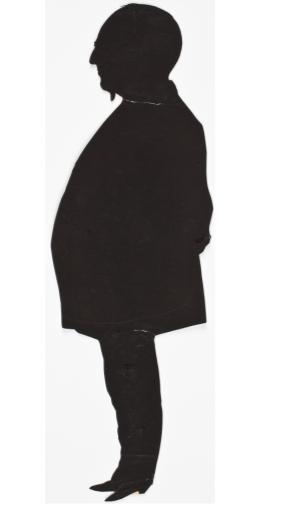
The American Antiquarian Society’s collection of just over two hundred American silhouettes has recently been cataloged and photographed and an inventory of these profile portraits is now available via a new digital resource.
Silhouettes were popular in the United States starting at the end of the eighteenth century. Profile drawings, profile miniatures, and silhouettes all benefited from the rise of the pseudo-sciences physiognomy and phrenology, which stated that head shape, profile, and facial features revealed basic elements of personality. The Swiss author Johann Kaspar Lavater issued a comprehensive, and widely read, multi-volume set of Essays on Physiognomy for the Promotion of the Knowledge and the Love of Mankind, which went through multiple editions in the United States between its release in 1775 and 1850. The market for silhouettes was robust in America right through the nineteenth century and continues in New England today.
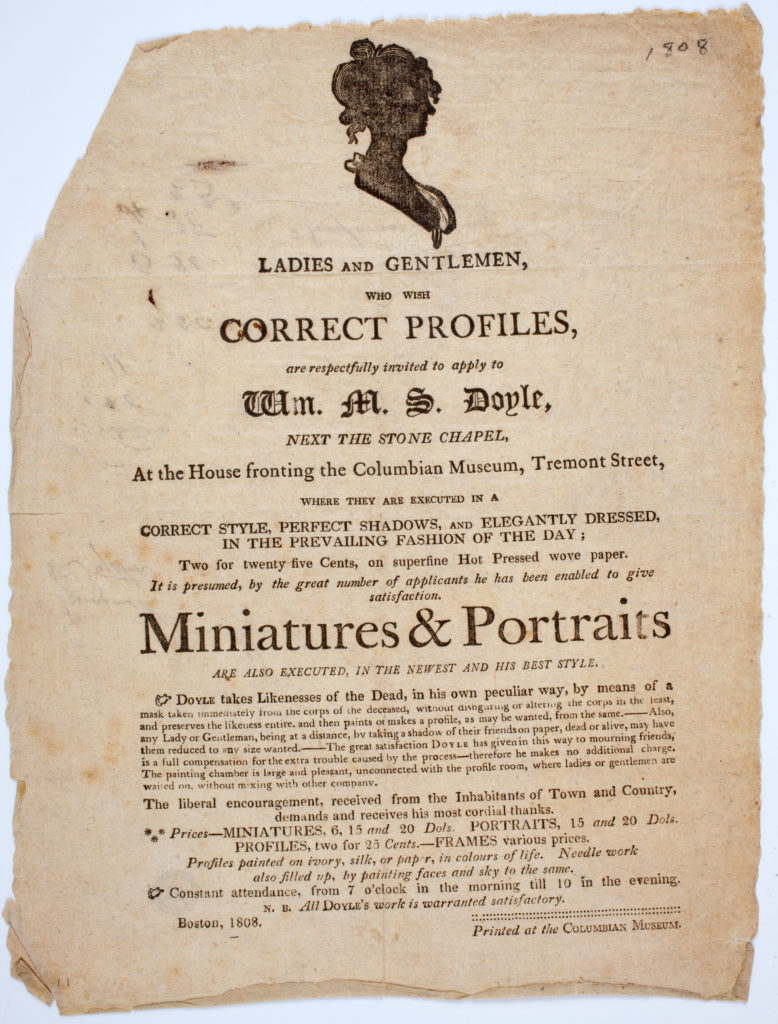 In June of 1864, Godey’s Ladies Book included an article on the practice of making and collecting silhouettes, commenting on what was then considered a quaint reminder of times gone by: “Much pleasing speculation can be made on the mental capacity of the heads before you, or rather, of the owners of their originals. If you believe in the science of phrenology, you may compare your friend’s intellectual, moral, and animal ‘propensities’. If you do not, you may still read their characters in their features for we are all of us, to a greater or lesser degree, disciples of Lavater, and believe that the ‘human face divine’ is the index to the heart.” Although the popularity of silhouettes peaked in America in the 1820s, they hung on parlor walls, were cased in lockets, and were playfully made at parties and celebrations well into the 1870s and 1880s.
In June of 1864, Godey’s Ladies Book included an article on the practice of making and collecting silhouettes, commenting on what was then considered a quaint reminder of times gone by: “Much pleasing speculation can be made on the mental capacity of the heads before you, or rather, of the owners of their originals. If you believe in the science of phrenology, you may compare your friend’s intellectual, moral, and animal ‘propensities’. If you do not, you may still read their characters in their features for we are all of us, to a greater or lesser degree, disciples of Lavater, and believe that the ‘human face divine’ is the index to the heart.” Although the popularity of silhouettes peaked in America in the 1820s, they hung on parlor walls, were cased in lockets, and were playfully made at parties and celebrations well into the 1870s and 1880s.
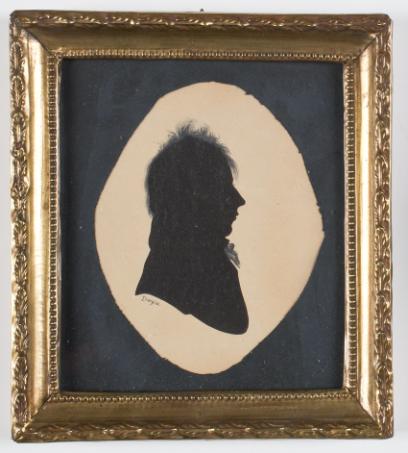
Ten broadsides in the Society’s holdings advertise silhouette artists and can be considered complementary to the silhouette collection. Many of these date from the pre-1820 era, when silhouettes sold for 25 cents for two copies. Boston artist William Doyle cut silhouettes at his Columbian Museum on Tremont Street in 1808, stating “Perfect Shadows executed in a Correct Style” available from “7 o’clock in the morning until 10 in the evening” (see above left). The Society’s collection includes seven silhouettes cut by Doyle, including one of Timothy Newhall Wood of Charlestown, Massachusetts (left).
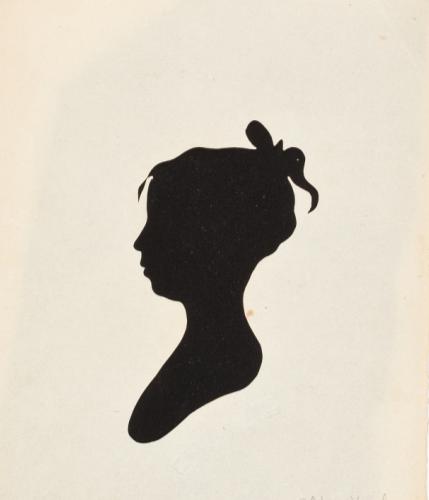
Other artists represented in the silhouette inventory include William King, also of Boston, Moses Williams, an African American indentured servant who cut thousands of silhouettes for visitors to Philadelphia’s Peale Museum, and Martha Ann Honeywell, who was born without arms and travelled New England cutting silhouettes by mouth. Over eighty hollow cut silhouettes (where the shape is cut from paper and the remaining hole is laid over black paper or fabric) by William Chamberlain of New Hampshire, made during his itinerant travels in New York and New England in the 1820s, were donated to AAS in 1916 by the artist’s granddaughter.
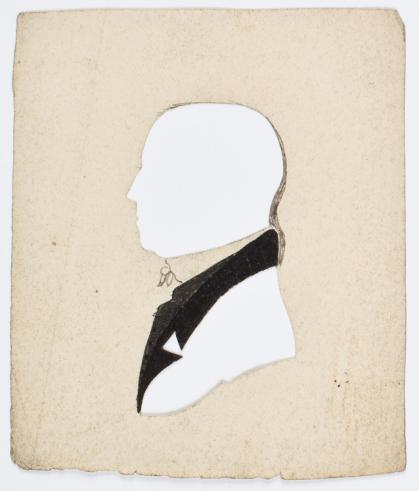
Many of the silhouettes depict individuals represented in our manuscript collections, including members of the Foster, Paine, and Salisbury families. The Society also holds paintings of several of these individuals, allowing scholars to compare and contrast silhouette depictions with traditional formal portraiture. This pair of images of Rebecca Faulkner Foster is an example of the rich visual information available now—her miniature can be compared to her silhouette, creating a nearly three-dimensional sense of her physical form. A prolific letter writer, Rebecca’s numerous missives to her husband, who was often away from their Brookfield, Massachusetts, home, also provide her a voice. Taken together, these objects and words are invaluable pieces of one woman’s long life.
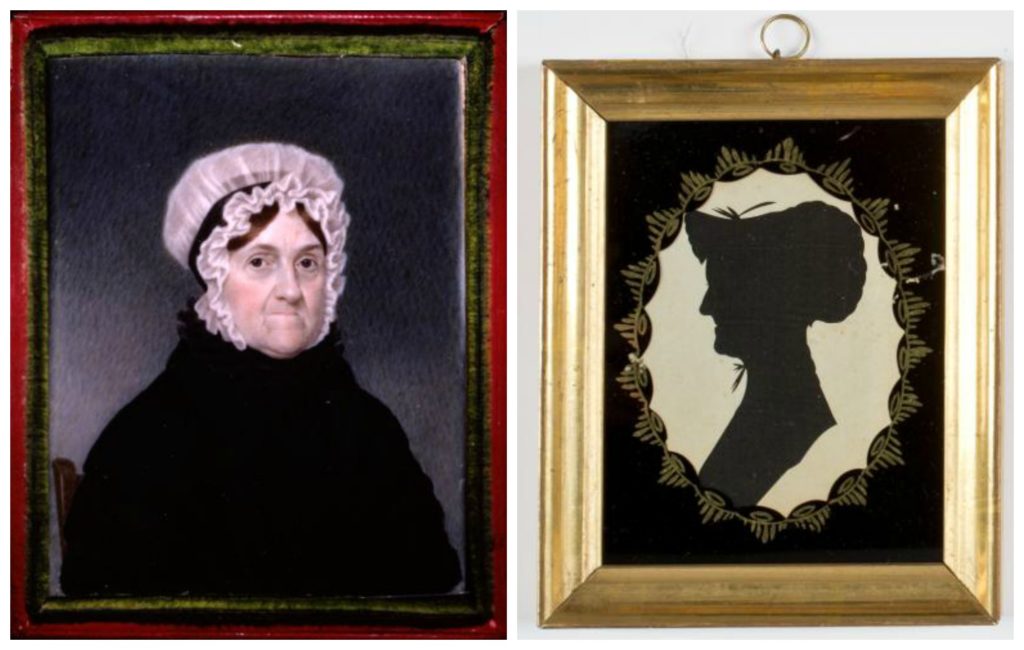
The new online silhouette inventory provides access to a portion of the Society’s outstanding portrait collection that heretofore has been available only by visiting the reading room in Worcester. We have already seen an increase in use of the silhouette collection because of this new access, with scholars interested in visual culture, hair styles, and work produced by African Americans and disabled artists all finding material of interest to their studies. This is our second online inventory of graphic collections using Omeka—the first documented a set of important photographs from the early years of the Tuskegee Institute—and more are on the way. Our visual materials cataloger is working with glass negatives, valentines, copy book covers, and more hidden collections, creating inventories and queuing up material for our photographer for documentation. Stay tuned!

Interesting article.
I remember that my mother had two silhouettes made of me when I was about thirteen. That would have been 1960, in Virginia. I vaguely remember her telling me that it was customary for young ladies to have their silhouettes made.
The silhouette maker sat at right angles to me, exhorting me to sit very still. I recall a bright light, and I think I remember hearing the paper being cut.
He made two silhouettes, one with my glasses on and one without. I thought the one with the glasses looked stupid because they didn’t look like glasses.
I think I still have those silhouettes in my attic.
Dear Nan,
Thank you for your comment. You should get those out of your attic and display them! In 1968 my sister and I also sat for silhouettes in upstate New York. Our mother and aunts all had theirs done in the 1950s and the pieces all hang together in a hallway of the family home. None of the male relatives were cut, unfortunately, so it is a bit lopsided in terms of family history.
Thank you, Lauren. I will do that when the weather is cooler.
I think that the “lopsided” aspect of family history, or any history, is what makes it intriguing.
Past is Present does an excellent job of bringing those bits of history to life, and to the public.